Caeciliusetae
Emilie Bess and Kevin P. Johnson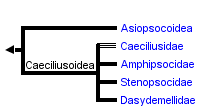


This tree diagram shows the relationships between several groups of organisms.
The root of the current tree connects the organisms featured in this tree to their containing group and the rest of the Tree of Life. The basal branching point in the tree represents the ancestor of the other groups in the tree. This ancestor diversified over time into several descendent subgroups, which are represented as internal nodes and terminal taxa to the right.

You can click on the root to travel down the Tree of Life all the way to the root of all Life, and you can click on the names of descendent subgroups to travel up the Tree of Life all the way to individual species.
For more information on ToL tree formatting, please see Interpreting the Tree or Classification. To learn more about phylogenetic trees, please visit our Phylogenetic Biology pages.
close boxIntroduction
Infraorder Caeciliusetae includes families Amphipsocidae, Asiopsocidae, Caeciliusidae, Dasydemellidae, and Stenopsocidae, comprising more than 60 genera and approximately 900 species. These bark lice are distributed worldwide; about half of the species are described from Asia. They are small to large in size, about 2–10 mm in length. Most live on live foliage, but species of Asiopsocidae live on bark.Characteristics
Synapomorphies:
- Prothorax has an elongate preepisternum.
- Forewing vein R has campaniform sensilla divided into two groups.
- Legs: Pretarsal claw lacks a preapical tooth.
- genitalia: External valve of the gonapophyses is reduced.
General Characters
- Head:
- Vertex is rounded.
- Ocelli are present and clustered on small tubercle.
- Mandibles are more or less elongate with outer margin angled.
- Galea is ball-shaped.
- Labial palpi are somewhat triangular.
- Thorax:
- Prothorax is less bulged dorsally than in other Psocomorpha.
- Preepisternum of prothorax is elongate.
- Pterothorax is greatly bulged dorsally in winged forms.
- Mesothorax has a broad precoxal bridge and narrow trochantin.
- Metathorax has a broad membranous region.
- Legs:
- Tarsi have 2 segments.
- Tarsal claws lack a preapical tooth.
- Wings:
- Forewings:
- Forewings vary in venation, size, shape, and color.
- Posteroproximal corner of forewing is smoothly rounded.
- Hindwings:
- Hindwing have a smoothly rounded posteroproximal corner.
- Hindwing hairs vary.
- Vein Sc is clear.
- Veins Rs and M , Cu are fused for long distance basally.
- Veins Rs and M are fused.
- Male genitalia:
- Hypandrium is simple, the posterior margin is smoothly rounded.
- Phallosome: Aedeagus is pointed apically and strongly arched in lateral aspect.
- Paramere extends along aedeagus and is strongly arched in lateral aspect.
- Phallobase is simple and narrow, anterior margin is not divided.
- Endophallus usually has a weakly sclerotized region but never with rod-like sclerites.
- Female genitalia:
- Subgenital plate is simply rounded or slightly hollowed posteriorly.
- Gonapophyses variable; external valve more or less reduced.
Discussion of Phylogenetic Relationships
Monophyly of Infraorder Caeciliusetae is strongly supported by morphological and molecular data. Molecular analysis included one nuclear gene (18S) and three mitochondrial genes (16S, 12S, COI; Johnson et al. 2004, Johnson & Mockford 2003). Morphological data support monophyly of the infraorder based on the synapomorphic characters listed under Characteristics (Yoshizawa 2002).References
Johnson, K. P. & E. L. Mockford. 2003. Molecular systematics of Psocomorpha (Psocoptera). Systematic Entomology 28: 409-40
Johnson, K. P., K. Yoshizawa, and V. S. Smith. 2004. Multiple origins of parasitism in lice. Proceeding of the Royal Society of London B 271: 1771-1776.
Lienhard, C. and C. N Smithers. 2002. Psocoptera (Insecta) World Catalogue and Bibliography. Muséum d'Histoire Naturelle, Geneva, Switzerland.
Mockford, E. L. 1993. North American Psocoptera (Insecta). Gainesville, Florida: Sandhill Crane Press.
Mockford, E. L. 2005. Order Psocoptera: Psocids. Pp. 341-355 in C. A. Triplehorn and n. F. Johnson (eds.) Borror and DeLong's Introduction to the Study of Insects. Belmont, California: Thomson Publishing.
Smithers, C. N. 1996. Psocoptera. Pp. 1-80, 363-372 (Index) in A. Wells (ed.) Zoological Catalogue of Australia. Vol. 26. Psocoptera, Phthiraptera, Thysanoptera. Melbourne: CSIRO Publishing, Australia.
Yoshizawa, K. 2002. Phylogeny and higher classification of suborder Psocomorpha (Insecta: Psocodea:'Psocoptera'). Zoological Journal of the Linnean Society 136: 371-400.
Title Illustrations

| Scientific Name | Graphopsocus cruciatus |
|---|---|
| Location | Dunstable, Ma. |
| Comments | 10/14/2007 |
| Specimen Condition | Live Specimen |
| Sex | m |
| Life Cycle Stage | adult |
| View | lateral |
| Copyright | © Tom Murray |
| Scientific Name | Valenzuela flavidus |
|---|---|
| Location | Groton, Ma. |
| Comments | 9/22/2007 |
| Specimen Condition | Live Specimen |
| Life Cycle Stage | adult |
| View | frontal |
| Copyright | © Tom Murray |
| Scientific Name | Matsumuraiella radiopicta |
|---|---|
| Location | Japan |
| Specimen Condition | Live Specimen |
| Identified By | K. Yoshizawa |
| Life Cycle Stage | adult |
| View | lateral |
| Size | 3mm |
| Copyright | © 2006 Kazunori Yoshizawa |
About This Page
Emilie Bess

Illinois Natural History Survey, Champaign, Illinois, USA
Kevin P. Johnson

Illinois Natural History Survey, Champaign, Illinois, USA
Correspondence regarding this page should be directed to Emilie Bess at and Kevin P. Johnson at
Page copyright © 2009 Emilie Bess and Kevin P. Johnson
All Rights Reserved.
- First online 25 March 2009
- Content changed 25 March 2009
Citing this page:
Bess, Emilie and Kevin P. Johnson. 2009. Caeciliusetae. Version 25 March 2009 (under construction). http://tolweb.org/Caeciliusetae/30254/2009.03.25 in The Tree of Life Web Project, http://tolweb.org/




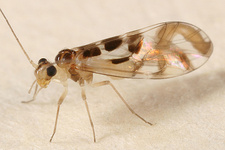
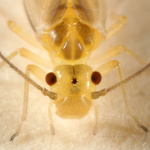
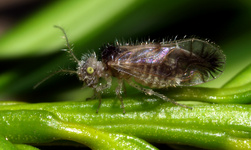
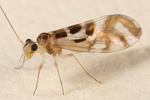



 Go to quick links
Go to quick search
Go to navigation for this section of the ToL site
Go to detailed links for the ToL site
Go to quick links
Go to quick search
Go to navigation for this section of the ToL site
Go to detailed links for the ToL site